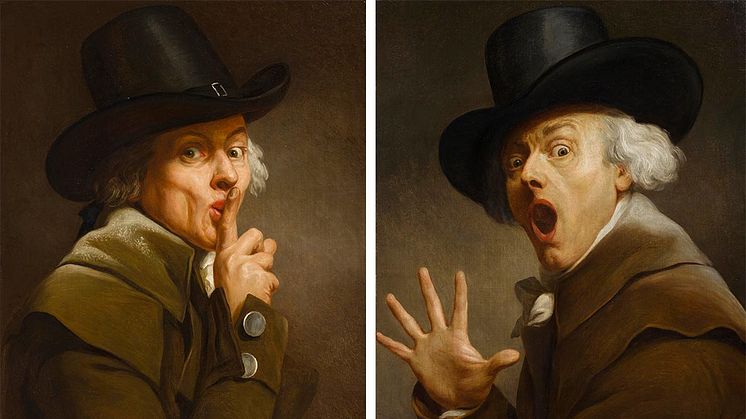
Press release -
Nationalmuseum acquires two self-portraits by Joseph Ducreux
Nationalmuseum has acquired two physiognomic self-portraits painted by the French artist, Joseph Ducreux, one of the foremost artists at the court of Louis XVI. Ducreux’s portraiture exhibits strong influences of naturalism and is characterized by the artist’s ability to capture a specific facial expression or emotional state. He shares this ability with the Austrian artist, Franz Xaver Messerschmidt.
Joseph Ducreux (1735–1802)was likely a student of Maurice Quentin de la Tour (1704–1788). The real launch of Ducreux’s career came when he was commissioned to paint a portrait of Marie Antoinette (1755–1793). In order to discover how the future French crown princess looked, the artist was sent to Vienna in 1769 with a commission to depict her. The result was so successful that Ducreux was subsequently made a baron and was given the title of “premier peintre de la reine”.
Because of this closeness to the royal family, and more particularly, the queen, Ducreux found himself in a perilous situation in the years immediately following the start of the French Revolution in 1789. He therefore took up residence in London during a period some time in 1791. There are few facts about Ducreux’s activities during this brief period, but we know that he exhibited portraits and self-portraits at the Royal Academy of Arts, including two that were called Surprise mixte [sic] with Terror and Surprise, respectively. Most likely, one of the portraits that Nationalmuseum has now acquired was a later version of the first of the two aforementioned works that had been exhibited in London. The facial expression of the artist is permeated with exaggerated surprise mixed with terror, as shown in his large eyes, gaping mouth and dramatically extended right hand. There is no doubt that these works are self-portraits, but their titles, which describe emotions, such as surprise, show that they were also intended to focus on physiognomy as a phenomenon, in itself.
The fact that Ducreux could return to Paris so soon, was most likely due to his acquaintance with Jacques-Louis David (1748–1825), the foremost artist of the Revolution. By August 1791, he once again exhibited his work in the Salon in Paris. One example is a work that the catalogue calls Silence, which is currently in the collection of the Spencer Museum of Art in Kansas. Ducreux’s expressive oil portraits, however, were met with both praise and scorn, but regardless garnered a great deal of notoriety, which, in turn, increased the demand for additional works of this sort. Nationalmuseum’s Silence is probably a later version by Ducreux of the work exhibited at the Salon. The artist is portrayed with a powdered wig, a top hat and a brown coat. As often was the case, some of the powder is seen on the artist’s shoulders and coat collar. The portrait depicts his upper body in profile, but the head is turned to the viewer. His right index finger is lifted to his mouth to clearly communicate the need to keep silent.
Ducreux’s interest in physiognomy reflects his time and can more generally be indicative of the favourite scientific theme of the Enlightenment. By combining an expressly physiognomic perspective with a self-portrait, this work may well be viewed as having laid the foundation for new directions in portraiture. This is in no way any kind of caricature, but neither does it any longer have anything of the formal and serious nature of traditional portraiture. Ducreux has attempted to capture in himself, facial expressions that we can see every day, on people, in general. It is perhaps not at all surprising that one of Ducreux’s self-portraits of this type has now become a popular on-line meme, which, in itself, shows this artist’s timeless playfulness and desire to experiment
“Nationalmuseum is happy to have been able to acquire these exceptional works, which are so characteristic of Joseph Ducreux’s self-portraits,” declares Daniel Prytz, curator at Nationalmuseum.
The newly acquired portraits by Ducreux can now be viewed, in the Museum’s presentation of its collections in one of the recently remodelled small rooms with 18th century art, which now includes portraits from the period of the French Revolution.
Nationalmuseum receives no state funding with which to acquire design, applied art and artwork; instead the collections are enriched through donations and gifts from private foundations and funds. The acquisition has been made possible through a contribution by the Sophia Giesecke Foundation.
Inventory numbers
Joseph Ducreux, Self-portrait, entitled Le Silence, 1790’s, oil on canvas. NM 7495
Joseph Ducreux, Self-portrait, entitled La Surprise en terreur, 1790’s, oil on canvas NM 7496
For more information
Daniel Prytz, curator, daniel.prytz@nationalmuseum.se, +46 (0)8 5195 4306
Hanna Tottmar, head of press, press@nationalmuseum.se, +46 (0)8 5195 4400
Categories
Nationalmuseum is Sweden’s museum of art and design. The collections comprise older paintings, sculpture, drawings and graphic art, and applied art and design up to the present day. The museum building has currently been renovated and reopened in autumn 2018. Nationalmuseum has partnerships with Svenska Dagbladet, Bank of America Merrill Lynch, The Wineagency and the Grand Hôtel Stockholm.

